Bridled darter
(Percina kusha)

Classification
General data
Percina kusha is restricted to the headwaters of the Coosa River in Georgia and Tennessee. It occurs in the main channel of the upper reaches of the Conasauga River in Murray and Whitfield counties, Georgia, and Bradley and Polk counties, Tennessee. It is also known from short reaches of three tributaries to the Conasauga River: Holly Creek, Murray County, Georgia; and Ball Play and Minnewauga creeks, Polk County, Tennessee. In the Etowah River it occurs in the main channel in Dawson and Lumpkin counties, Georgia, and in several tributaries: Amicalola, Little Amicalola, Cochran and Shoal creeks, Dawson County, Georgia.
Max length : 6.5 cm SL
Percina kusha is distinguished from all other described species of Percina by a combination of the following characteristics: absence of bright colors on body and fins of adults; no orange band in spinous dorsal fin; no broad vertical bands on body extending dorsally across the back joining those of the other side; 7–11 lateral blotches connected to form a continuous dark brown to black lateral stripe with undulating margins; lateral stripe continuous with large, quadrate basicaudal blotch that extends onto base of caudal fin rays; small, dark blotch on upper and lower portion of caudal fin base, dorsal blotch typically darker; body below lateral stripe white to cream colored, without dark blotches, dusky in breeding males; suborbital bar absent or very poorly developed; lateral line complete, typically no pored scales on base of caudal fin; males with row of modified scales on midline of belly and one or two modified scales between base of pelvic fins; modified breast scale absent; nuptial tubercles absent; anal fin of breeding males not excessively elongate; males without caudal keel as a ventral extension of the caudal peduncle; snout not projecting beyond anterior margin of upper jaw; well-developed premaxillary frenum; serrae on margin of preopercle absent; branchiostegal membranes overlapping or very narrowly joined.










